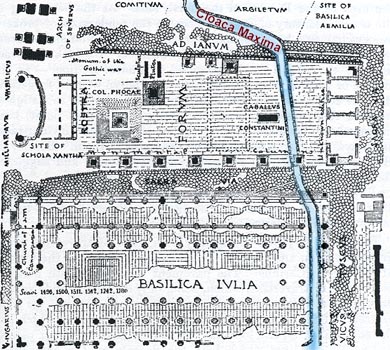The Cloaca Maxima was one of several large ditches that drained
water from inhabited areas of the City of Rome. The Cloaca Maxima
drained the valleys between the Esquiline, Viminal, and Quirinal
Hills, as illustrated here:

It traveled along the Argiletum into and across the the Forum:

Eventually, it made its way to the Tiber River by way of the
Velabrum. The debouche of the Cloaca into the Tiber can still
be seen. In the 19th century it had not yet been covered by the
present day embankment, as can be see in this 19th century painting:
.jpg) |
This detail from the painting shows the Cloaca more clearly:

The modern embankment encloses it considerably, but it is
clear that the Cloaca still performs some drainage function.

The ditch was open for many centuries, but was covered over at least by the time of the censorship of Cato the Elder (184 BCE), whose restorative work on the Cloaca earned him a statue in the Temple of of Salus (Public Welfare).
As sanitation devices, Lanciani says, the sewers of Rome were much over-rated, since they did not appear to service private houses and since they dumped raw sewage as well as rain water into the Tiber River. But the Cloaca Maxima has a special importance in the history of the City, since it was only after the Claca drained the swampy Forum area that it could be used as a civic center. This project is traditionally dated to Tarquin the Proud (late 6th century BCE).